When in February 2012 SAP AG took over SuccessFactors, an alternative for traditional applications for SAP ERP human resources management appeared.
Today we already know that SuccessFactors is not an alternative, but the future of SAP. Regardless whether we use standard SAP solutions in the field of human resources management or we are only considering the possibility of implementing traditionally understood SAP HR, it is worth becoming familiar with what SuccessFactors has to offer.
In this article, we are reviewing SuccessFactors regarding evaluation of employee’s performance and we conduct the entire process – from creating a form template, through employees’ self-evaluation, to evaluation by the supervisor.
In particular, we check whether the tools to conduct employees’ evaluation are intuitive and flexible in operation, whether the process can be adjusted to the individual needs of a given organization, and how the application motivates the process participants to implement its subsequent steps.
Welcome to SuccessFactors
For SAP users transferring into the SuccessFactors reality is definitely a positive change. SF offers a more pleasant, more intuitive and modern interface than SAP itself.
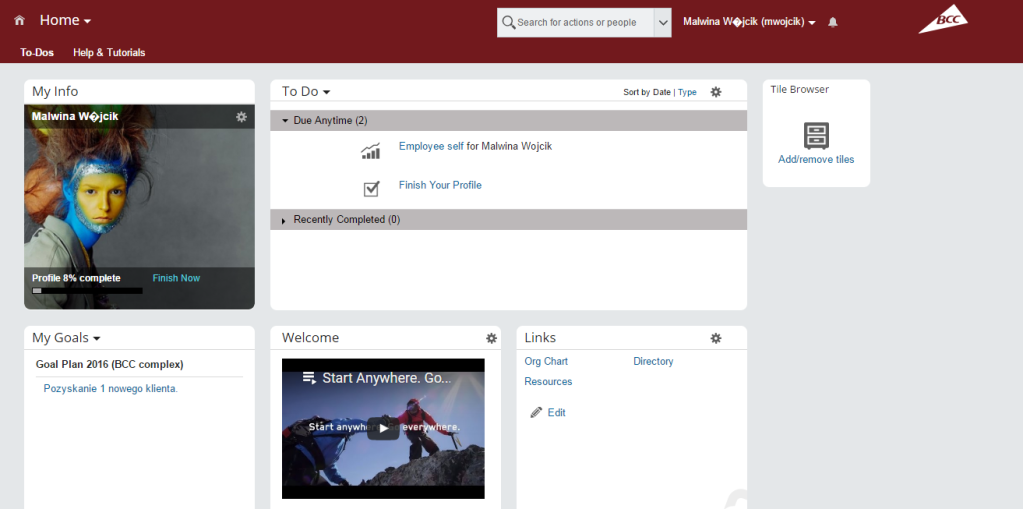
User interface of SuccessFactors – homepage. The list of tasks includes an employee self-evaluation form
Is it about performance?
As registered users, from the drop-down menu of the homepage we can select one of SuccessFactors modules. The module referring to employees’ evaluation is called Performance.
SF configuration in Provisioning allows selecting a language in which we will work in our application. Provisioning is a place where the implementation consultant performs the basic configuration of SuccessFactors for the customer; among others, it allows using various languages.
At some companies the nomenclature assumed for some processes can vary from the one used in the tool and e.g. the word Performance is not related intuitively to employees’ evaluation. In the SF application we can change the terms normally used to terms suitable for the customer – terms which will have a clear meaning for employees (e.g. Periodical evaluation, Evaluation, etc.).
Employees’ evaluation in SF
However, before an employee can activate the evaluation form in the Performance module, the form should be prepared earlier. We will therefore review the subsequent steps in the process of preparing the system for annual employees’ evaluation at SNP.
Preparing the template of the employee’s evaluation form
All steps to prepare the template of the employee’s evaluation form and the activation of the form itself are available in the Administrator Center, after selecting the icon Performance management.
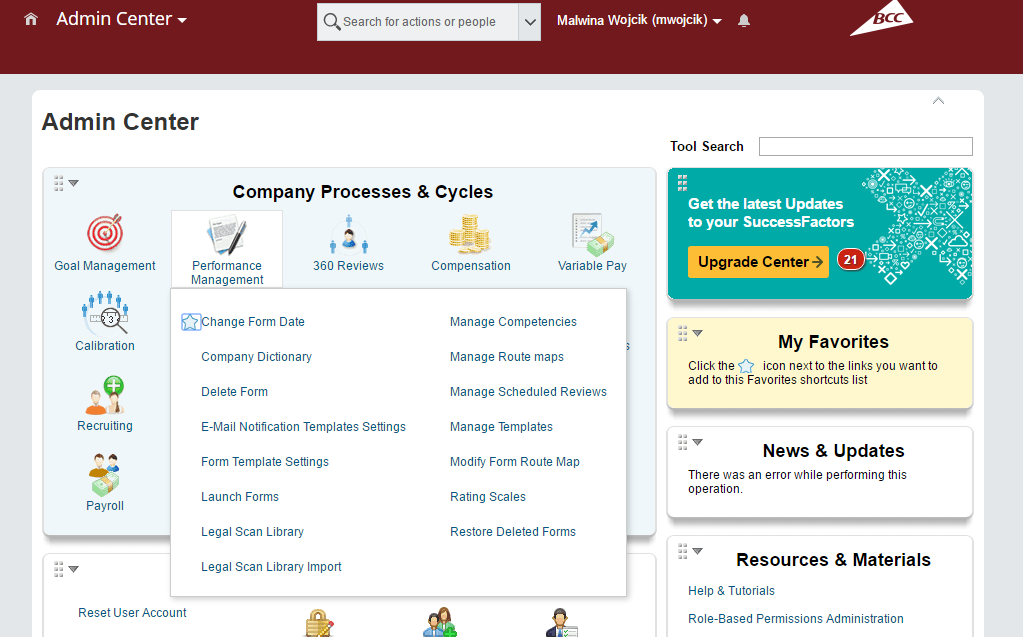
Administrator Center in SuccessFactors
The Administrator Center is a place in SuccessFactors in which users with appropriate administration authorization can undertake actions related to system management, such as a change of the user’s password, modification of authorizations or preparation of the forms of employees’ evaluation.
SuccessFactors contains a list of standard templates of the forms that can be used after adjusting them to the internal specificity. It is important to differentiate two terms: the form template and the form itself, generated on the basis of the template. The form template is a matrix based on which particular forms for determined groups of employees are created and shared at a given time. The form is a specific document sent using workflow to be completed by particular users in the system.
From one template, we can generate numerous forms. However, if none of the available templates fulfills our expectations we can create our own. It will be saved and it can be used multiple times, in subsequent cycles of employees’ evaluations.
For demonstration needs, a template of the evaluation form was created under the name Employee’s development and evaluation questionnaire. The tool to create form templates is easy and intuitive to operate.

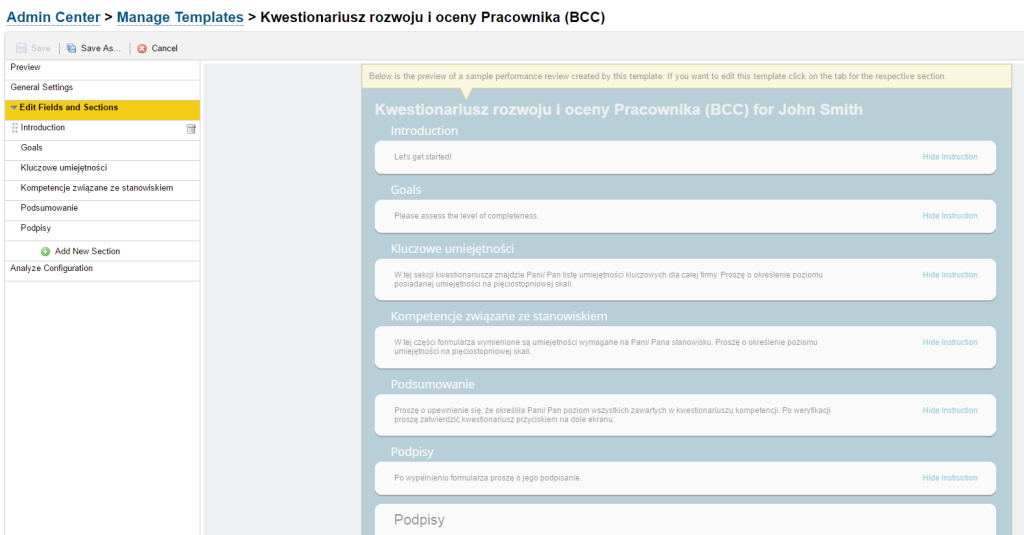
List of form templates in the Administrator Center and an exemplary template of Employee’s development and evaluation questionnaire
Defining particular sections that will be included in the evaluation form, we can simultaneously establish their detailed characteristics. Each section will receive an adequate heading and description with the instruction manual specifying what it concerns or in what way the employee should complete it.
As creators of the template, we will decide whether a given section of the form can be edited in the evaluation process or whether users can add notes and comments to it.
If in our form we wish to verify implementation of goals previously presented to the employees, we can link the section Goals with the Plan of goals to be implemented applicable to the employee.

Linked sections: Goals with Plan of goals to be implemented applicable to the employee
The plans of goals are used in the module Goals and – similarly to evaluation forms – they can be adjusted to the customer’s needs. Linking the plan of goals applicable to the employee (in our example it is the Plan of goals for 2016) will cause that in the evaluation form created by us the application will automatically import the goals previously assigned to the employee and we do not have to look for them or verify them independently. We can decide whether the person completing the form should be able to add goals, which were not assigned to the Employee earlier, and whether they can evaluate the degree of their implementation.
In the employee’s evaluation form, we can include a section where it will be possible to evaluate the level of particular skills. Some competencies can be defined as fundamental for the company and then they will be identical for each employee in the group of people completing a given form. Another group of competencies can result directly from the specificity of the employee’s position (job specific competencies). As a result, the same form sent to the group of employees at various positions will include different competencies specific for a given group.
In the template of the employee’s evaluation form we can create a summarizing section in which additional information for the person completing the form will be included, or a section of signatures confirming the completion and verification of information by particular people involved in the evaluation process of a given employee.
From 1 to 5 or from 5 to 1 – the evaluation scale
Establishing particular sections in the form template and deciding on elements that will be evaluated, we should decide according to what scale they would be evaluated.
The SF application offers a wide range of already defined scales, which can be used in our form. Obviously, we can also create our own scale to evaluate elements included in the form. However, we should point out that we can only assign one template to one scale, which will be used in the evaluation of all elements included in the form.
All settings of the created form template can be seen in the process of conducting Configuration Analysis.
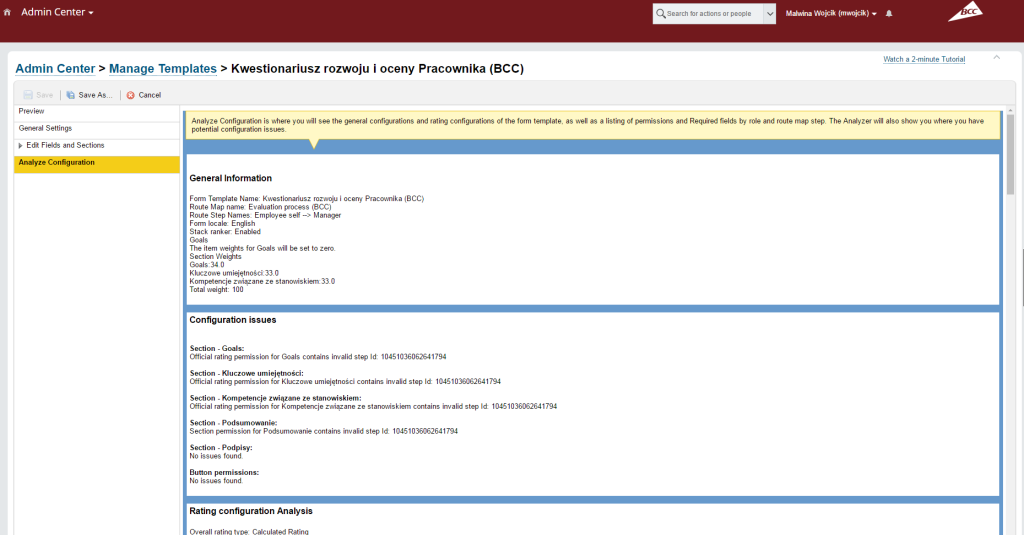
Configuration analysis of the evaluation form template
Form transfer map
Having prepared the evaluation form template, we should define who and to what extent will participate in the employee’s evaluation process. In SuccessFactors, a transfer map is used to define Workflow already known from SAP.
Similarly as in the case of evaluation scale, SP creators provided the application with already defined transfer maps that can be used in our form. If none of them fulfills our expectations, we can easily create our own. The easiest way to do so is to modify one of the maps already existing in the system and save it as our own.
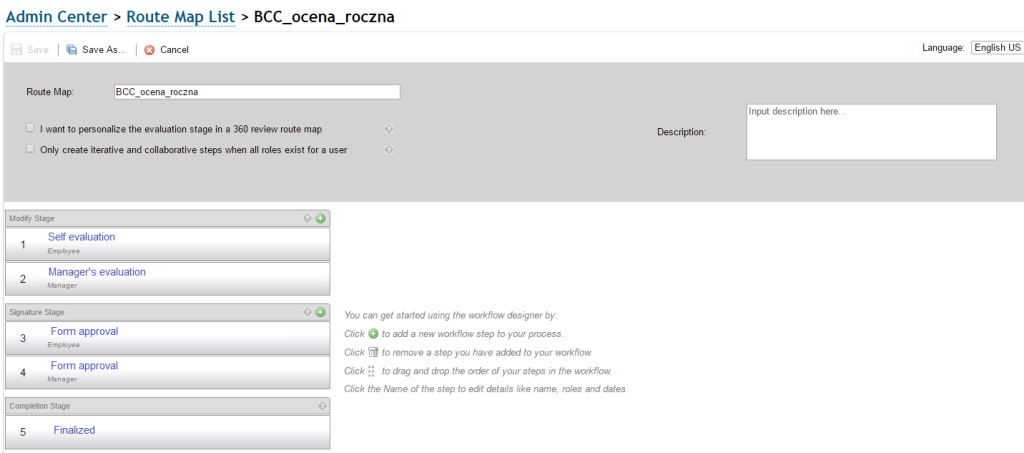

Form transfer map, configuration of subsequent transfer stages
At each step requiring user’s actions we can define whether a given step will be performed by one person on their own (e.g. employee’s self-evaluation), taking several people in a so called loop into account (coordination of the evaluation between the employee and their immediate supervisor; the stage will be completed when the content is agreed between both people), or within simultaneous cooperation of numerous people (evaluation of a given employee by co-workers).
We also indicate at whom a given step is addressed (employee, immediate supervisor, second level manager) and when (date) a given step will be activated.
Additionally, on the map we also define the stages of signing and finishing the process of completing the form.
The saved transfer map is attached to the evaluation form template.
Employee’s evaluation form – Go!
We have defined what elements should be included in the evaluation form, what scale will be used, to whom and in what order it should be provided. We have a ready form template.
As it was mentioned before, the template is a model based on which we will be able to send the employee’s evaluation form many times. In order to ensure that a given employee receives the evaluation form, we need to activate it, defining among others whether it should be sent once or cyclically. The form may be received by one person, but also by a selected group of employees or all employees.
After approval of the decision to send the form, the target group of recipients will see a notification about the form waiting to be completed in the SP main screen in the section of tasks to be implemented.
Within the time defined in the form, employees should complete the evaluation form and finish this stage, transferring the form to the subsequent stage of the process (determined in the transfer map). Before the form is transferred further, the system will verify whether all obligatory elements were completed.
When employees are ready to transfer the form further, they can leave a comment for their supervisor.
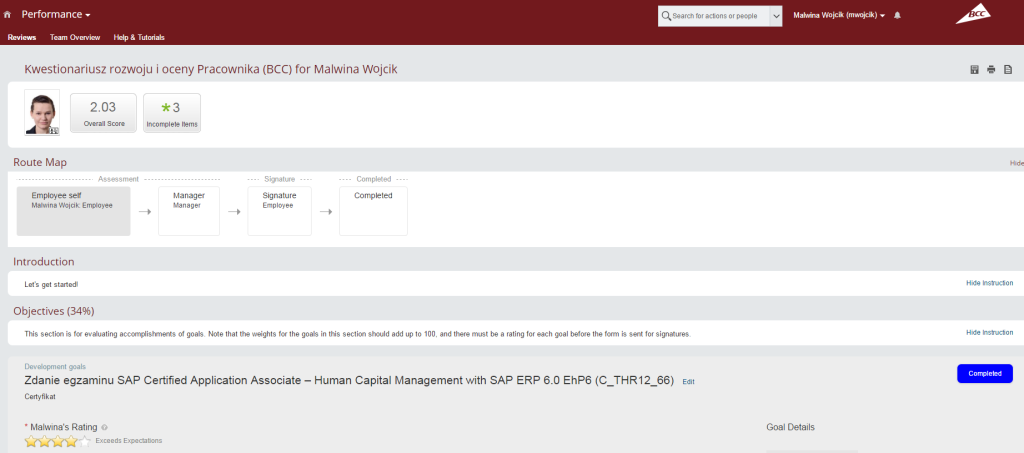
Automatic correctness verification of the form
After finalization of the stage of completing the evaluation form by a given employee, the form is transferred to another person defined in the transfer map. In our example, the completed form is transferred to the immediate supervisor.
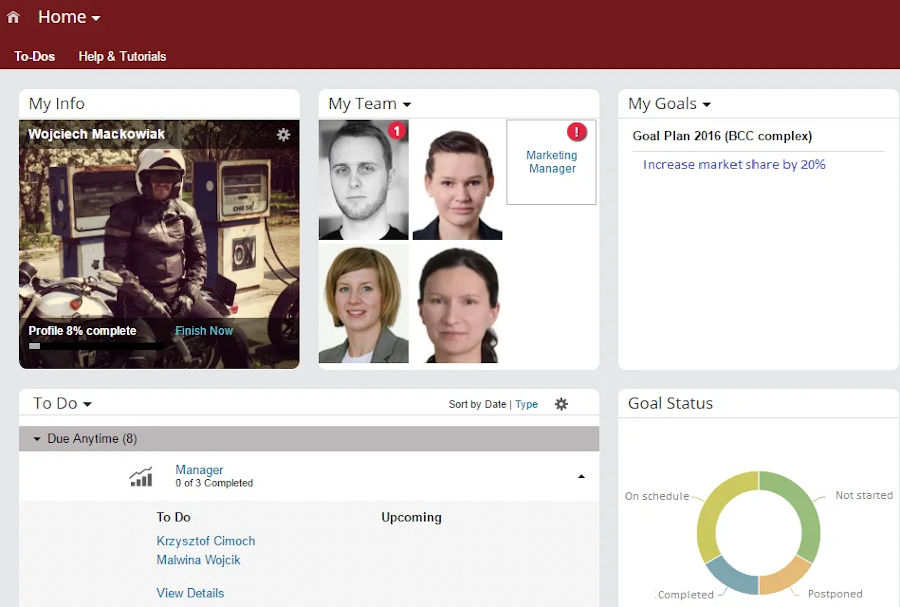
SuccessFactors homepage of the Supervisor with employee evaluation forms visible on the list of tasks
The test drive has been completed
Activation of exemplary employee’s evaluation for the needs of our analysis based on the module Performance offered in SuccessFactors took place in a short time and it proceeded in an intuitive manner. Completing the evaluation form and transferring it is easy and quick. A significant advantage is how easy it is to configure evaluation forms and to link them with other elements existing in the system (e.g., the plan of goals assigned to a given employee).
However, there were elements that required particular attention. The system offers Polish as the user’s language, while field labels are not always translated well and they may not be clear for the user. It is possible to change them, but we need to find a way to do this. Additionally, using elements from various modules (plan of goals, assigning qualifications to a position) in the employee’s evaluation form required SNP consultants to delve into technical details of data maintenance in the SF system. It may constitute a difficulty in independent configuration of templates by business users.
The module Performance in SuccessFactors is a flexible solution that can increase the rank of cyclical employees’ evaluation at a company. The self-evaluation form, the possibility for employees to leave comments, as well as an intuitive and aesthetic interface make it easier for both parties to obtain exhausting information. Not only does the employee obtain feedback on how they are evaluated by their supervisors, but they also have the possibility to communicate their feelings to the employer. It is particularly important in the current situation on the employment market in which attracting talented personnel and maintaining their satisfaction from work becomes one of the most important challenges for organizations.

